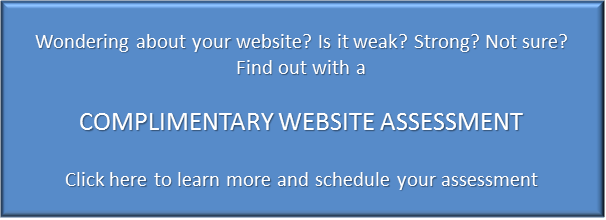 An investment management firm’s website is its most easily-accessed, publicly-available piece of marketing.
An investment management firm’s website is its most easily-accessed, publicly-available piece of marketing.
Unfortunately, in the context of today’s digital marketing environment, too many managers are content to think of their site as a “digital brochure.”
That’s like limiting your smartphone usage to voice only.
How can firms of all stripes better leverage the power of their website on behalf of their investment management marketing strategy?
Identifying the Purpose of Your Site
I’ve found that while the vast majority of investment managers have a website, few have really thought through what it is supposed to do, in anything but the vaguest of terms.
An investment management firm’s website should accomplish five primary tasks:
- Describe who you are, what you do, how you do it, and why in a clear, persuasive manner;
- Provide clear differentiation from competitors operating within the same investment niche;
- Demonstrate an unusually thoughtful approach to client service;
- Offer visitors great content that ultimately results in AUM growth; and
- Deliver the content on a website that is modern, professional, properly structured, and responsive (i.e.: functions equally well on computers and mobile devices).
Unfortunately, the vast majority of investment management websites fail on most, if not all of these accounts. In no particular order:
Mistake #1: It is old
At this point, having an old, out-of-date site is inexcusable.
The costs of website development have fallen dramatically, to the point where template companies such as Squarespace, offer a do-it-yourself service that results in a highly professional, scalable, and responsive website that is likely light years better than what many have now.
Important consideration: websites today must be responsive; in other words, the site can read the type of browser that’s accessing it (i.e.: phone, tablet, desktop/laptop), and automatically reorganizes and optimizes the content and layout to its best effect.
Mobile browsing is now ubiquitous, and a responsive website is a must.
Worried about the opportunity costs of developing the site in-house? Hire us to do it.
Mistake #2: Poor organization
Website content for investment managers is often poorly organized. This typically results from a lack of knowledge about the best practices for website usability for investment managers. A (non-exhaustive) list of traps includes:
- More than one menu (a menu on the top AND a side menu, each linking to different content).
- Not setting up enough pages on the site. What usually results is long pages of unrelated content that requires the audience to scroll, scroll, scroll…
- Pages which aren’t intuitive to find (“Investment Philosophy” page nested under the “About Us” menu item).
- On-page content that is thematically unfocused (investment philosophy, investment process, client service, and investment products all hosted on the same page).
- Using PDF documents in place of HTML-based website content. An absolute no-no.
Mistake #3: Jargony content
Investment managers - know that given your industry and the nature of your job, the presumption is that you are smart.
As such there is no need to beat your audience over the head with buzzword salads of industry jargon in an effort to show off your chops.
For your audience, it is equal parts boring, confusing, and needlessly obfuscating. It doesn’t make you seem smart or professional – it suggests that you have no idea how to communicate with people.
Whether your audience consists of consultants, institutions, or individual investors, each will be more impressed by content that’s plainly written, persuasive, and interesting.
Remember – clearly describing who you are, what you do, how you do it, and why is a vital, yet under-appreciated aspect of differentiating your firm.
If you sound like everyone else, then you’re the same as everyone else in some pretty important ways.
Mistake #4: Use of “Worst Practices” in Content Composition
Most of us figure out what it means to be a good writer in college. Unfortunately, academic writing is unsuited to marketing and online website content for investment managers.
Important above almost all else, website content must be skimmable, allowing your audience to quickly and easily determine if you have the information they need, enabling them to locate that information fast and quickly get the gist of what you have to offer.
Some of the worst practices include:
- Paragraph-based content. Long paragraphs are inherently un-skimmable. Break up the content using headers, sub-headers, and numbered lists and bullet points.
Also, make sure paragraphs have no more than 5 sentences. Each paragraph should contain no more than one main idea. - Compound sentences. Compound sentences usually string together multiple ideas, opposing “either-or” concepts, and lists. These should be broken up into individual sentences, or re-organized into nested lists.
- Building to a strong conclusion. This may seem counter-intuitive, but website content should be written in an “inverted pyramid style,” with the conclusion coming FIRST, so your audience can see, up front, what you piece is all about (remember – SKIMMABLE!), with the supporting details following.
Website usability for investment managers means that the site and its content are organized and articulated in ways its audience wants - NOT in the ways the manager wants.
Mistake #5: No clearly-articulated Value Proposition
I think the reason many firms neglect the creation of a strong, clearly articulated value proposition is because they believe in their inherent differentiation. For example,
-
they believe their investment process to be unique,
- their philosophy on the markets unimpeachable, and/or
- they allow their performance to speak for itself.
Importantly, all three of these are, in their minds, completely self-evident.
Here is the reality: even if your process and philosophy are unique and unimpeachable, that makes it even more important to explain the how and the why.
Without that clarification, the distinctions are easily lost.
And I’ve written about this before, but performance is a terrible differentiator. Doing good work is important, but there are hundreds of firms out there, managing billions in assets that have middling-to-poor performance numbers.
Conversely, there are lots of firms doing very good work, but are struggling to attract assets.
The difference? Effective marketing.
To wit: if you are a large cap value manager, there are more than 650 competing products in the market (according to a screen on eVestment on 2/12/16). So, if you have top quartile performance means there are 162 other firms out there just like you.
Top decile? 65
Investment management firms need to conceive of and describe their business in ways that demonstrate the ability to create added value BEYOND portfolio returns.
Mistake #6: No clear distinction between Philosophy and Process
Philosophy is the why – process is the what. Many, many, many firms conflate the two.
Too often, the philosophy is a multi-paragraph dissertation that does little to offer the audience any clarity. Want to clearly explain the philosophy? Great, use as much virtual ink as you’d like, but have that single, clear statement up front.
Importantly, when a firm does not clearly differentiate between philosophy and process, and treats them as the same, it suggests a firm has muddled thinking about its core business processes.
Not good.
Mistake #7: Inconsistent Messaging
Rarely does a firm revisit all of their marketing materials at once.
For example, a firm might revise the pitchbook at one time, the website at another, and the fact sheets at yet another.
Additionally, one of the firm’s principals might be interviewed, give a speech, or write an article that describes some (or every) aspect of a firm’s operations.
And the RFP? Sometimes it never gets revisited.
What’s important to note is that creative processes allow us to consider familiar ideas in different ways. Often, that process leads to a better way of thinking about something, as well as a new, clearer way of articulating it.
When that creative process is applied unevenly across the full library of marketing materials, what should be a unified message becomes distorted over time.
If you haven’t done so lately, read your RFP. If it hasn’t been recently updated, how accurately does it articulate your firm’s operations, compared to the website and pitchbook?
Clearly, the website must reflect the most up-to-date thinking about your firm’s operations. Your ancillary materials should do the same.
Mistake #8: You are Giving it All Away
Let's say you spent 15 hours, or paid a writer $5,000, to write a white paper. You email it out to your clients and prospects, then post a link for download on your website.
Bad move. But why?
You have no idea what people are doing with it. Are they reading it? Did they open the email, but not download the piece? Did they simply delete the email? Did they forward it to all of their colleagues? Post a link to it on their blog? Tweet it out?
Investing time and money creating something of value isn't easy, so simply giving it away for free (and ensuring you've lost "control" of it) makes no sense. But what do I mean by "free?"
I'm not talking about money here; rather, ask visitors to complete a simple form with their name, email, and company in exchange for your white paper.
They obtain something of real value, and you now have a lead, a person with whom you can share additional expertise, and from whom you can get a sense of their needs, wants, pain points, and all manner of issues that keep them up at night.
In other words, you will get a better understanding of your clients and prospects. If your content has real value for your audience, they will gladly trade their contact information in exchange for your expertise.
But what if you write it and nobody fills out a form to get it?
Well, now you know something - there’s either no market for what you are saying, or it isn’t sufficiently valued by the "market." Forms enable money managers to begin the process of obtaining first-hand intelligence about what the audience is interested in... as well as what they're not.
That doesn't mean you stop writing - it means that you need to better understand what your clients and prospects want.
When you've added value to the relationship, you've done two things: built trust and demonstrated a differentiated approach to your business. These are two of the most difficult qualities to establish in the investment management industry.
One more thing: we often think that we're being a "bother." But the reality is that we are being helpful. Although help isn't always accepted, it's almost never resented.
Mistake #9: No thought to measuring ROI
How can investment managers measure the ROI of their website? The typical measurement, growth in AUM, is a frustratingly inaccurate, shortsighted metric in this case.
There are no impulse buys in the investment management industry, so a manager's website isn't a money-generating machine along the same lines as those for B2C companies like Amazon, Banana Republic, or Cabela's.
It's why too many firms conceive of their website as their "digital brochure," and leave it at that.
But an investment manager's website can and should be a lead-generating machine. And that is accomplished in two ways:
- offering great content that demonstrates a differentiated value proposition; and
- measuring how that content is received by the audience.
Create great content in the form of web copy, blogs, eBooks, white papers, and video. Distribute it on the website, through your email list, and the relevant social media channels.
Once it's out, use analytics programs, either free (such as Google Analytcs) or paid (e.g.: HubSpot) to see how the library of content is being engaged and used by the audience.
Create forms for visitors to fill out in order to gain access to your best content, and add the submissions to your distribution list. Track their engagement and use that intelligence to create additional content that solves the same or similar problems preoccupying your audience.
This is one of the underlying principles of Inbound Marketing for investment managers.
In order to track ROI, investment managers should know why people are visiting their site, and then structure the content and the position the content strategy in a way that helps them to better understand an investment manager's value, making it easy for both sides to connect.
A small sample of ROI key performance indicators (KPI) include:
- overall website traffic
- page performance
- organic search traffic
- page conversion rates (the percentage of people visiting a page divided by the number who click on a CTA or fill out a form)
- website traffic sources
Taken together, the site should offer useful, actionable content and enable easy paths to convert visitors into leads through the effective use of forms, calls-to-action, and relevant offers ("Free Portfolio Review," for example).
Mistake #10: No SEO
Search Engine Optimization, particularly as it relates to Google, should be an incredibly important component to an investment management digital strategy.
SEO is the process by which an investment manager's website content and structure is made more relevant to search engine algorithms than those of their competitors.
That's a fancy way of saying that when a user types in the search terms describing your business, or the problems to which you can offer a solution, your website content comes in ahead of your competitors.
But SEO isn't easy... and it's confusing. Conduct a Google search for "effective SEO techniques" and a bajillion articles will pop up, many of which offer sometimes contradictory advice. SEO is a multi-billion dollar industry at this point, so there is no shortage of research being done by SEO firms, trying to gain unique insights (and thus an edge) on their competitors.
But for most firms starting out, there are a few tried-and-true methods for better optimizing your content and site structure:
- Figure out what you want to be known for, then conduct keyword research into the ways your buyer personas might try to find someone like you via search;
- Write often, and include those keywords in the text. Over time, this will help a firm to build authority in those keywords, which will boost ranking on the search engine results page (SERP);
- Make sure the website is responsive, and thus optimized for mobile devices;
- Distribute content on the relevant social media channels in order to more widely distribute the piece, and thus draw a larger, more diverse audience.
For the vast majority of investment management firms, the website is an underutilized tool. Interested in learning your site's strengths and weaknesses?





